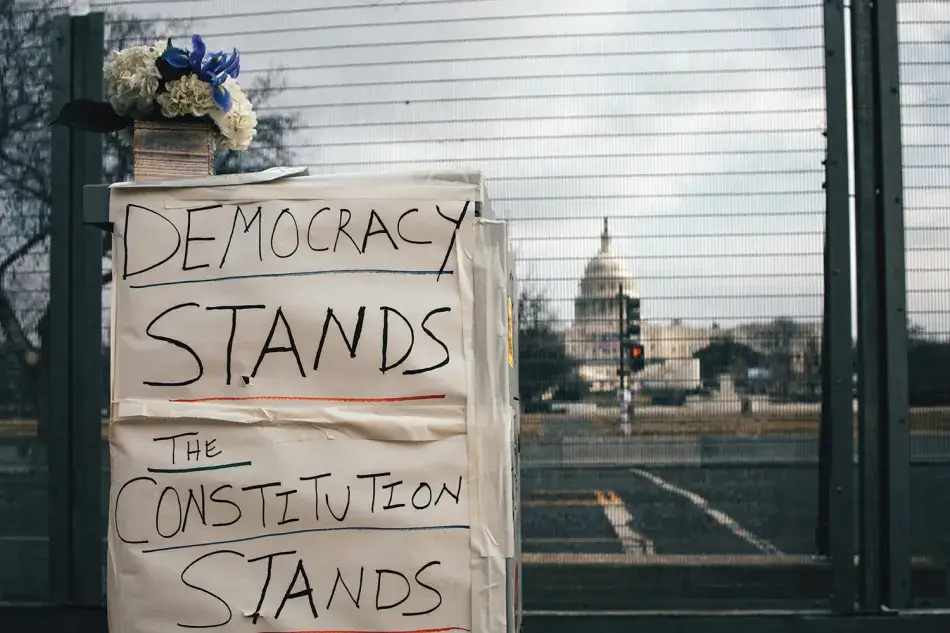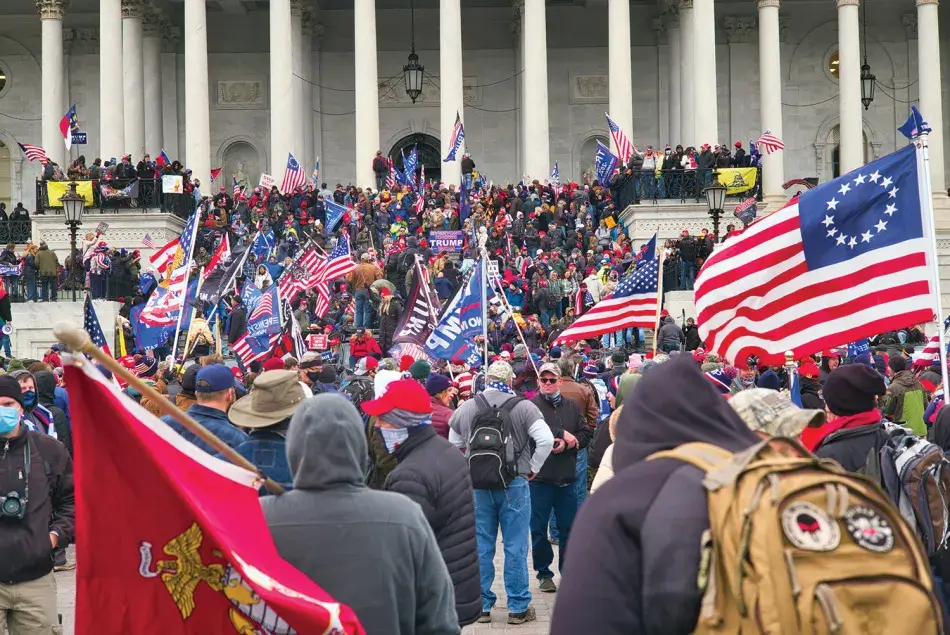
By Michelle Poulin, Program Associate for Global Security and International Affairs at the Academy, and Melissa Chan, Program Coordinator for Global Security and International Affairs at the Academy
On September 22–23, 2022, the Academy convened an exploratory meeting to discuss the effects of prolonged war on democracy. Chaired by Neta C. Crawford (Montague Burton Professor of International Relations, University of Oxford) and Scott D. Sagan (Caroline S.G. Munro Professor of Political Science, Stanford University), the meeting was held under the Chatham House Rule. The participants included political scientists, historians, lawyers, policy-makers, anthropologists, and academics as well as retired U.S. military personnel and a Washington, D.C., reserve police officer. The attendees shared their expertise in militarization, civil-military relations, democratic erosion, gender and security issues, White supremacy movements, and budgeting and public finance to explore the relationships between long-term militarization, extremism, and democracy, both within the United States and abroad.
As a response to the concern that the world is still feeling the aftershocks of the U.S.-led wars in the post-9/11 era, the participants focused on whether prolonged war erodes the foundations of democracy by exacerbating conditions of inequality and political polarization. They considered how long-term militarization affects the democratic ethos within the armed forces, with a particular focus on the United States. Some participants expressed concern that the U.S. military has inadvertently and indirectly contributed to the rise of White nationalism and other extremist views. Observing the 2020 U.S. presidential election and its aftermath, including the Capitol riots on January 6, 2021, of which 20 percent of the instigators had military backgrounds, the participants articulated a fear that prolonged war, even after the withdrawal of U.S. troops from Iraq and Afghanistan, may have persistent and damaging consequences on democracy within the United States.
The meeting focused on two concerns: 1) Does the mobilization for war, and war itself, foster or diminish democratic norms, institutions, and practices? 2) What are the linkages between military bias, militarism, and extremism, and, in parallel, between militarization and democratization?
Keynote Address: Addressing Extremism in the U.S. Military
The exploratory meeting began with a keynote address on possible causal links between American military participation and political extremism and the potential solutions to ameliorate future radicalization. Drawing upon their public- and private-sector experience, the speaker analyzed the U.S. military’s capacity to support veterans’ transition to civilian life. They noted that a lack of sufficient post-service social support has contributed to higher rates of self-harm and political radicalization among former soldiers and Department of Defense contractors (compared to civilian populations).
Although many American policy-makers agree that providing services to improve veterans’ mental health and prevent radicalization should be a nonpartisan issue, the speaker observed that increased politicization of the issue and polarization in the armed forces have impeded efforts to make significant improvements. This, in turn, has created a feedback loop in which civilians are becoming more aware of radicalized veterans, which aggravates an existing atmosphere of distrust between veterans and civilians. Distrust begets further radicalization, which amplifies distrust on both sides. The speaker warned that this deterioration of the military-civilian relationship could hasten democratic erosion and may also enable future autocrats to use the military for their own goals.
Concepts and Theories of Militarism, Democratization, and Democracy
During the first panel of the meeting, the presenters considered the extent to which the past two decades of American militarism have affected the health of democracy in the United States. They noted that nationalist values are promoted and exacerbated in countries that fight long wars with ill-defined goals and no clear winner, and they predicted that both military spending and militarism in the United States will increase in the years to come. The panelists cautioned that this increase will threaten American democracy, as it will provoke extremist frameworks, including dehumanization of the other and overestimation of the efficacy of violence. The panelists discussed that new technology is making war itself less democratic because mass mobilization is no longer necessary to engage in war; for example, drones and nuclear weapons can be deployed using relatively few people.
Several participants indicated interest in examining how countries transition from military-industrial models to environmental equity models. They questioned the effectiveness of democracy in supporting such a transition and noted that authoritarianism can allow for rapid investment in green industries (e.g., China’s investment in electric cars) while policy change in democracies like the United States can be slow and limited in scope. The discussants agreed that reconciling environmental equity goals with democratic mechanisms will be complicated and deserves further discussion.
Comparative Perspectives on Militarization, Democratization, and Democracy
The second panel focused on civilians’ declining trust in democracy and their increasing faith in and deference to the military in the United States, Australia, and many African countries. The panelists noted that overall military spending is not predictive of civilian trust in the military; rather, the lack of civilian trust in institutions and politicians is predictive of civilian trust in the military.1 When the military fails, civilian trust in the military does not decrease; the public instead doubles down on its distrust of civilian institutions. In the case of America’s invasion of and withdrawal from Afghanistan, for example, the public tends to blame insufficient civilian financial, legal, and political support for the military’s failure.2 In certain cases, civilian acceptance of blame for poor military outcomes may indicate that democracy is functioning.
While many Americans believe that engaging in war protects American democracy, research shows that the opposite can be true. Soldiers conduct repressive activities abroad in ways that would not typically be acceptable within the borders of the United States. When soldiers finish their tours and join police forces and paramilitary organizations, some tend to normalize the use of repressive tactics on civilians back home.3 Several of the participants noted that soldiers are not the only culprits; in Iraq and Afghanistan, more than half of the Department of Defense’s representatives were non-military contractors.4 These civilian contractors are just as likely to use and capable of importing and imposing repressive war-related tactics as their military counterparts.

U.S. Militarism and Extremism
Presenters in the third panel discussed the recent rise in veterans’ recruitment to White supremacist extremist groups. The panelists grappled with the challenge of reintroducing traumatized survivors of war to civilian life; the evidence shows that veterans often struggle to find purpose and meaning in both their experience at war and their new experiences at home. When combatants return from wars that are difficult to justify, like those in Iraq and Vietnam, they may feel angry that their fellow soldiers and contractors died in vain. In the post-Vietnam era, racist extremist groups gained momentum by taking advantage of returning veterans’ despondence. They recruited and continue to recruit veterans by characterizing the world as facing an impending apocalypse and offering order and community amid this chaos.
Unlike conscripted soldiers of the Vietnam era, the panelists explained that today’s volunteer veterans are more insulated from civilians, who they feel do not understand the sacrifices made at war. This lack of understanding makes veterans more likely to seek community among other veterans, ultimately gravitating toward one another in extremist groups. The discussants emphasized, however, that there is no one path to radicalization. As one panelist stated, “There are as many paths to White supremacy as there are White supremacists.”
As paths to extremism have multiplied and grown, so has militarization of historically civilian roles and institutions in the United States. Over the past few decades, the military has significantly increased its budget to cope with the expanding list of duties it is asked to perform, from vaccination administration to event security and border patrols. As the military’s responsibilities grow, it is natural to ascribe possible threats to those activities. As one panelist stated, “We’ve come to view an ever-wider range of international threats through the laws of war,” particularly the Law of Armed Conflict and International Humanitarian Law. Where the armed forces were historically and primarily responsible for fighting wars, they now increasingly oversee humanitarian responses within their enlarged capacity, so there is a growing tendency to view nonviolent security threats, like health and education, through the lens of war.
The same panelist noted that the Law of Armed Conflict is “tolerant of state secrecy, violence, coercion, and reduced human rights, but is met with less accountability.” According to Article 2(4) of the United Nations Charter, armed conflict toward another state is permissible in cases of self-defense.5 The relationship between threats, war, and the military is not clear cut, but perceptions of security threats can be used to promote national defense, which in turn can contribute to the rise of U.S. militarism and a corresponding increase in militaristic operations.
The Effects of War on the Rule of Law, Democracy, and State Capacity
During the final panel of the meeting, the presenters described the material and opportunity costs of war. Historically, wars were financed at least partially by civilians. The Iraq War was the first American conflict in which there were no cuts to non-military domestic spending; the wars in Iraq and Afghanistan were funded by off-budget emergency spending. Taxes did not increase during this period as they had during previous wars, and in fact were reduced three times. This created an economic disconnect between civilians and war, and this superfluous spending, according to the panelists, lacked accountability and bred corruption, profiteering, and ghost spending for projects that did not exist.
The last two decades of emergency war funding allowed Congress to appropriate money for war efforts without making any trade-offs. This significantly relaxed congressional pressure to contain military spending and led to increased militarization of America’s foreign policy strategy.
The participants shared that this expansion of unfettered military funding has been accompanied by an increase in domestic policing. Through the Department of Defense’s 1033 program, more than $1.6 billion in military equipment has been transferred to domestic police since September 11, 2001.6 This massive supply and accumulation of military-grade equipment among domestic police forces have incentivized law enforcement to use force, often excessively and problematically, to address ordinary infractions that historically were resolved without recourse to military intervention.
The group shared that domestic police forces lack oversight by the communities they police. The panelists predicted that increases in police militarization and a lack of accountability may lead to more American civilians living with the threat of police violence. The panel members also observed that decreasing accountability post-9/11 has resulted in an uptick in unchecked National Security Agency (NSA) surveillance, a nationwide increase in aggressive sting operations, and growing domestic and international terrorist watchlists.
Next Steps
The meeting ended with a discussion of topics for further exploration, such as:
- veterans’ recruitment into right-wing extremist organizations;
- the psychological and social elements that influence which veterans fall into extremism and which do not;
- crucial next steps to counter imminent threats to democracy; and
- the need for a comparative study of the political beliefs of demobilized soldiers in twentieth-century wars.
The Academy is exploring future work and research efforts for the Global Security and International Affairs program area. For current work, visit www.amacad.org/topic/global-affairs.